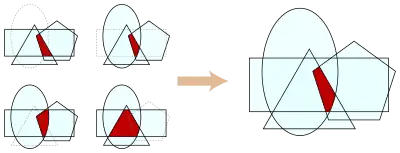Helly's theorem
Helly's theorem is a basic result in discrete geometry on the intersection of convex sets. It was discovered by Eduard Helly in 1913,[1] but not published by him until 1923, by which time alternative proofs by Radon (1921) and König (1922) had already appeared. Helly's theorem gave rise to the notion of a Helly family.

Statement
Let X1, ..., Xn be a finite collection of convex subsets of Rd, with n ≥ d + 1. If the intersection of every d + 1 of these sets is nonempty, then the whole collection has a nonempty intersection; that is,
For infinite collections one has to assume compactness:
Let {Xα} be a collection of compact convex subsets of Rd, such that every subcollection of cardinality at most d + 1 has nonempty intersection. Then the whole collection has nonempty intersection.
Proof
We prove the finite version, using Radon's theorem as in the proof by Radon (1921). The infinite version then follows by the finite intersection property characterization of compactness: a collection of closed subsets of a compact space has a non-empty intersection if and only if every finite subcollection has a non-empty intersection (once you fix a single set, the intersection of all others with it are closed subsets of a fixed compact space).
The proof is by induction:
Base case: Let n = d + 2. By our assumptions, for every j = 1, ..., n there is a point xj that is in the common intersection of all Xi with the possible exception of Xj. Now we apply Radon's theorem to the set A = {x1, ..., xn}, which furnishes us with disjoint subsets A1, A2 of A such that the convex hull of A1 intersects the convex hull of A2. Suppose that p is a point in the intersection of these two convex hulls. We claim that
Indeed, consider any j ∈ {1, ..., n}. We shall prove that p ∈ Xj. Note that the only element of A that may not be in Xj is xj. If xj ∈ A1, then xj ∉ A2, and therefore Xj ⊃ A2. Since Xj is convex, it then also contains the convex hull of A2 and therefore also p ∈ Xj. Likewise, if xj ∉ A1, then Xj ⊃ A1, and by the same reasoning p ∈ Xj. Since p is in every Xj, it must also be in the intersection.
Above, we have assumed that the points x1, ..., xn are all distinct. If this is not the case, say xi = xk for some i ≠ k, then xi is in every one of the sets Xj, and again we conclude that the intersection is nonempty. This completes the proof in the case n = d + 2.
Inductive Step: Suppose n > d + 2 and that the statement is true for n−1. The argument above shows that any subcollection of d + 2 sets will have nonempty intersection. We may then consider the collection where we replace the two sets Xn−1 and Xn with the single set Xn−1 ∩ Xn. In this new collection, every subcollection of d + 1 sets will have nonempty intersection. The inductive hypothesis therefore applies, and shows that this new collection has nonempty intersection. This implies the same for the original collection, and completes the proof.
Colorful Helly theorem
The colorful Helly theorem is an extension of Helly's theorem in which, instead of one collection, there are d+1 collections of convex subsets of Rd.
If, for every choice of a transversal – one set from every collection – there is a point in common to all the chosen sets, then for at least one of the collections, there is a point in common to all sets in the collection.
Figuratively, one can consider the d+1 collections to be of d+1 different colors. Then the theorem says that, if every choice of one-set-per-color has a non-empty intersection, then there exists a color such that all sets of that color have a non-empty intersection.[2]
Fractional Helly theorem
For every a > 0 there is some b > 0 such that, if X1, ..., Xn are n convex subsets of Rd, and at least an a-fraction of (d+1)-tuples of the sets have a point in common, then a fraction of at least b of the sets have a point in common.[2]
See also
Notes
- Danzer, Grünbaum & Klee (1963).
- Kalai, Gil (2019-03-15), "News on Fractional Helly, Colorful Helly, and Radon", Combinatorics and more, retrieved 2020-07-13
References
- Bollobás, B. (2006), "Problem 29, Intersecting Convex Sets: Helly's Theorem", The Art of Mathematics: Coffee Time in Memphis, Cambridge University Press, pp. 90–91, ISBN 0-521-69395-0.
- Danzer, L.; Grünbaum, B.; Klee, V. (1963), "Helly's theorem and its relatives", Convexity, Proc. Symp. Pure Math., vol. 7, American Mathematical Society, pp. 101–180.
- Eckhoff, J. (1993), "Helly, Radon, and Carathéodory type theorems", Handbook of Convex Geometry, vol. A, B, Amsterdam: North-Holland, pp. 389–448.
- Heinrich Guggenheimer (1977) Applicable Geometry, page 137, Krieger, Huntington ISBN 0-88275-368-1 .
- Helly, E. (1923), "Über Mengen konvexer Körper mit gemeinschaftlichen Punkten", Jahresbericht der Deutschen Mathematiker-Vereinigung, 32: 175–176.
- König, D. (1922), "Über konvexe Körper", Mathematische Zeitschrift, 14 (1): 208–220, doi:10.1007/BF01215899, S2CID 128041360.
- Radon, J. (1921), "Mengen konvexer Körper, die einen gemeinsamen Punkt enthalten", Mathematische Annalen, 83 (1–2): 113–115, doi:10.1007/BF01464231, S2CID 121627696.